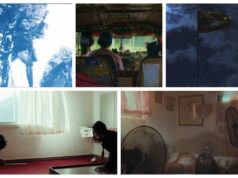By Joseph L. Garcia
Exhibit
Tapas: Spanish Design for Food
Ongoing until June 16
Metropolitan Museum
of the Philippines,
Bangko Sentral Complex,
Roxas Blvd., Manila
BE WARNED: when you visit the Metropolitan Museum of Manila’s new exhibition, Tapas: Spanish Design for Food, you will leave both hungry — for food — and full — of knowledge.
The exhibit is less about food, and more about the triumph of design in Spanish culture, and how design permeates even such prosaic moments as drinking water, eating soup, and dunking cookies in milk. By the power of good design, the moment is elevated into an experience.
For example, the exhibition of around 300 items includes a large display of crockery. Looking like ordinary ceramic bowls and cups at first glance, one learns upon reading the notes that they had been especially designed — to get the last drop of soup, or to dunk a large cookie in milk without having to break it. There’s a chopping board for bread that catches crumbs through holes and leads these to a birdfeeder. Some of the products are prototypes, while some are already on sale.

The exhibit also presents slices of Spanish humor, for example, through ham. Balloons printed with realistic pictures of ham are presented as Jamon de la Crisis (Crisis Ham), poking fun at post-financial crisis austerities.
Just to emphasize the point about the pervasiveness of art and design even in the mundane, you might be surprised to find out that the logo for Chupa Chups lollipops was designed by Salvador Dali. There are also videos on cooking Spanish treats, but these are not instructional. A video of making churros was set to Satie’s Gymnopedie No. 1, making it seem as if a chore had been transformed into a ritual.
The curator of the travelling exhibit, architect and designer Juli Capella, talked about his work, Jamon de la Crisis. “I love to start exhibitions with this, because it’s a joke,” he said.
“I try to mix serious products… with some points of irony.”
He also highlighted some designs that tackle social concerns, such as little pegs stuck on packages so blind people can “see” and tell products apart with their hands.
It took him one year to collect and curate all the pieces, he said, travelling across Spain to talk with designers and chefs. Photos of past exhibits are also included in Tapas, such as a photo and video of furniture made from bread from 2008 (of course it’s gone).
While other exhibits are best enjoyed alone, with a bit of meditation and reverence, this is an exhibit to enjoy with friends; with joie de vivre and enthusiasm. The pieces almost breathe with life, inviting you to participate in life, and not to step back from it.
“Life [mixes] the useful with the artistic… the needs with the symbolism,” he said. “But [they] realize… in the kitchen… the objects are more functional, more rational. Why? Because when you are cutting… a fish; must be precise. You cannot do strange shapes… because it will be a disaster. But when you are on the table, the imagination… [grows].
“So, in the table, [there’s] more freedom.”
As the exhibit presents slices of Spanish life, it’s interesting to note how design, art, and food should represent the country. “If you check the best 50 [restaurants] in the world, Spain has four [of them]. So… we are in the avant-garde of gastronomy,” said Mr. Capella.
“If I title this exhibition the Contributions of Spanish Design for Restaurants… nobody comes,” he said with some humor, explaining the title of the exhibit. “And it’s difficult to translate… but Tapas is an iconic word. It’s international. You don’t need to translate [it].”
The exhibit is on view at the Met until June 16. Lectures, design forums, tastings, and screenings are scheduled throughout the exhibition run. Admissions to the exhibit are P100 per person.



